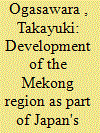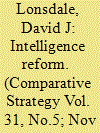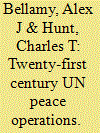| Srl | Item |
| 1 |
ID:
138748


|
|
|
|
|
| Summary/Abstract |
Japan's active engagement in the development of the Mekong region since the 1990s needs to be understood not only from an economic but also from a diplomatic perspective. Japan seeks to collaborate with ASEAN in facilitating multilateral “political dialogue” in the Asia-Pacific region and building an East Asian order based on “universal values” such as democracy and the rule of law, and the Mekong region could be the “weakest link” of ASEAN. After outlining Japan's twenty-year undertaking to cultivate Mekong-Japan cooperation, the author suggests that it is time to broaden the scope of the cooperation and accelerate Japan's “proactive contribution to peace” policy to cope with the changing security environment.
|
|
|
|
|
|
|
|
|
|
|
|
|
|
|
|
| 2 |
ID:
116349


|
|
|
|
|
| Publication |
2012.
|
| Summary/Abstract |
In recent years the intelligence communities of the United States and the United Kingdom have faced a rapidly changing security environment. In that time, a number of high-profile failures have exposed weaknesses within these communities and how they perform their tasks. This article analyses these failures, identifying the key problems, and examines the various reforms designed to overcome the identified weaknesses. These reforms are discussed in three categories: structural change, budget increases, and increased oversight procedures. The article concludes with an assessment of whether said reforms have produced intelligence communities ready for the new security environment.
|
|
|
|
|
|
|
|
|
|
|
|
|
|
|
|
| 3 |
ID:
142429


|
|
|
|
|
| Summary/Abstract |
United Nations peace operations are deployed in greater numbers to more difficult operating theatres in response to more complex conflict situations than ever before. More than 100,000 UN peacekeepers are deployed in missions mandated under Chapter VII of the UN Charter to use ‘all necessary means’ to protect civilians from direct harm as well as to achieve a host of other tasks such as supporting the (re)building of state institutions, facilitating humanitarian aid, and overseeing compliance with ceasefire agreements and political commitments. With increasing regularity, UN peacekeepers are instructed to complete these tasks in contexts where there is no peace to keep or where peace is fragile. To understand these changes, and the implications for UN peace operations, this article examines three key transformations: the emergence of the protection of civilians as a central mission goal (and accompanying principles of due diligence); a subtle move away from peacekeeping as an impartial overseer of peace processes towards the goal of stabilization; and a so-called ‘robust turn’ towards greater preparedness to use force. It identifies the challenges posed to contemporary UN peacekeeping operations by these transformations and evaluates the UN's efforts thus far to make peacekeeping fit for purpose in the twenty-first century, noting that while significant progress has been made in areas such as policy and guidance, force sustainment and deployment, and the application of force enablers, there remains a considerable way to go.
|
|
|
|
|
|
|
|
|
|
|
|
|
|
|
|